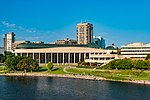Canadian Postal Museum
1971 establishments in Quebec2012 disestablishments in QuebecCanadian Museum of History CorporationDefunct museums in CanadaFormer education in Quebec ... and 7 more
Museums disestablished in 2012Museums established in 1971Museums in GatineauNational museums of CanadaPhilatelic museumsPhilately of CanadaPostal museums

The Canadian Postal Museum (CPM) was a museum once housed within the Canadian Museum of Civilization in Gatineau, Quebec. It was described by the Smithsonian Museum as being one of the five largest postal museums in the world, ranking second in annual attendance. The museum was not primarily about postage stamps, although it has a first-class collection that numbered in the tens of thousands. Rather, it presented the broader story of Canada's postal heritage, including the social and economic importance of postal communications throughout the country's history. It also explored international themes relating to postal communications.
Excerpt from the Wikipedia article Canadian Postal Museum (License: CC BY-SA 3.0, Authors, Images).Canadian Postal Museum
Rue Laurier, Gatineau Hull
Geographical coordinates (GPS) Address Website Nearby Places Show on map
Geographical coordinates (GPS)
| Latitude | Longitude |
|---|---|
| N 45.429722222222 ° | E -75.708888888889 ° |
Address
Canadian Museum of History
Rue Laurier 100
K1A 0M8 Gatineau, Hull
Quebec, Canada
Open on Google Maps









